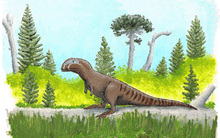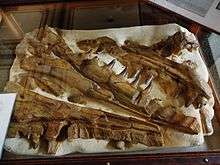Maastricht Formation
| Maastricht Formation Stratigraphic range: Maastrichtian–Danian | |
|---|---|
| Type | Geological formation |
| Underlies | Houthem Formation |
| Overlies | Gulpen Formation |
| Thickness | 30–90 m (98–295 ft) |
| Lithology | |
| Primary | Chalk |
| Other | Marl, flint |
| Location | |
| Region | Europe |
| Country |
|
| Type section | |
| Named for | Maastricht |

The Maastricht Formation (Dutch: Formatie van Maastricht; abbreviation: MMa), named after the city of Maastricht, the Netherlands, is a geological formation in the Netherlands and Belgium whose strata date back to the Late Cretaceous, within 500,000 years of the Cretaceous–Paleogene boundary,[1] now dated at 66 million years ago. The formation is part of the Chalk Group and is between 30 and 90 metres (98 and 295 ft) thick. It crops out in southern parts of Dutch and Belgian Limburg and adjacent areas in Germany. It can be found in the subsurface of northern Belgium and southeastern Netherlands, especially in the Campine Basin and Roer Valley Graben. Dinosaur remains are among the fossils that have been recovered from the formation.[2]
Lithology
The Maastricht Formation consists of soft, sandy shallow marine limestone (in Limburg locally called "mergel"), in fact chalk and calcareous arenite. These lithologies locally alternate with thin bands of marl or clay. The lower parts of the formation contain flint concretions. The upper parts can have shellrich layers. Its age is between about 70 and 66 million years, which puts it in the Maastrichtian, a stage that was named after the formation. The top of the formation can possibly be Danian (early Paleocene) in age.
The type locality is at the ruins of Lichtenberg castle on the Sint-Pietersberg, Maastricht.
Stratigraphy
The Maastricht Formation was first described by Belgian geologist André Dumont in 1849. The formation is subdivided in seven members, from top to bottom these are the Meerssen Member, Nekum Member, Emael Member, Schiepersberg Member, Gronsveld Member, Valkenburg Member and Kunrade Member. The members are often hard to distinguish.[3]
The Maastricht Formation is overlain by the Paleocene Houthem Formation and was deposited on top of the older Gulpen Formation.
Vertebrate paleofauna
Dinosaurs
Color key
|
Notes Uncertain or tentative taxa are in small text; |
| Dinosaurs reported from the Maastricht Formation | ||||||
|---|---|---|---|---|---|---|
| Genus | Species | Location | Stratigraphic position | Material | Notes | Images |
| Betasuchus | B. bredai | Geographically present in the Dutch province of Limburg. | "Femur."[4] | An abelisauroid.[2] |  | |
| M. bredai | Geographically present in the Dutch province of Limburg. | Reclassified as Betasuchus bredai.[2] | ||||
| Orthomerus | O. dolloi | Geographically present in the Dutch and Belgian provinces of Limburg. | A dubious hadrosaurid.[2] | |||
| Indeterminate euhadrosaurian remains | Geographically present in the Dutch province of Limburg. | A hadrosauroid.[2] | ||||
| "Unnamed ornithurine" | Unnamed | A basal ornithurine closely related to Ichthyornis.[1][5] | ||||
| "Unnamed ornithurine" | Unnamed | An ornithurine.[1][6] | ||||
| "Unnamed enantiornithine" | Unnamed | An enantiornithine.[1][6] | ||||
Mammals
Color key
|
Notes Uncertain or tentative taxa are in small text; |
| Mammals reported from the Maastricht Formation | ||||||
|---|---|---|---|---|---|---|
| Genus | Species | Location | Stratigraphic position | Material | Notes | Images |
|
Maastrichtidelphys |
M. meurismeti |
Geographically present in the Dutch province of Limburg. |
"Right upper molar." |
|||
Mosasaurs
Color key
|
Notes Uncertain or tentative taxa are in small text; |
| Mosasaurs reported from the Maastricht Formation | ||||||
|---|---|---|---|---|---|---|
| Genus | Species | Location | Stratigraphic position | Material | Notes | Images |
|
C. belgicus |
||||||
|
C. fraasi |
Junior synonym of C. belgicus. |
|||||
|
G. fraasi |
Reclassified as Carinodens fraasi | |||||
|
L. sectorius |
||||||
|
M. hoffmanni |
Holotype |  | ||||
|
M. lemonnieri |
||||||
|
P. marshi |
||||||
See also
References
- 1 2 3 4 Longrich, N.R.; Tokaryk, T.; Field, D.J. (2011). "Mass extinction of birds at the Cretaceous–Paleogene (K–Pg) boundary". Proceedings of the National Academy of Sciences. 108 (37): 15253–15257. doi:10.1073/pnas.1110395108. PMC 3174646. PMID 21914849.
- 1 2 3 4 5 Weishampel, David B; et al. (2004). "Dinosaur distribution (Late Cretaceous, Europe)." In: Weishampel, David B.; Dodson, Peter; and Osmólska, Halszka (eds.): The Dinosauria, 2nd, Berkeley: University of California Press. Pp. 588-593. ISBN 0-520-24209-2.
- ↑ See for example: Stratigraphy of the ENCI quarry, by H. Zevenberg
- ↑ "Table 4.1," in Weishampel, et al. (2004). Page 78.
- ↑ Dyke, G.J; Dortangs, R.W.; Jagt, J.W.M.; Mulder, E.W.; Schulp, A.S.; Chiappe, L.M. (2002). "Europe's last Mesozoic bird". Naturwissenschaften. 89 (9): 408–411. doi:10.1007/s00114-002-0352-9. PMID 12435093.
- 1 2 Dyke, G.J.; Schulp, A.S.; Jagt, J.W.M. (2008). "Bird remains from the Maastrichtian type area (Late Cretaceous)". Netherlands Journal of Geosciences. 87 (4): 353–358. doi:10.1017/S0016774600023404.
- ↑ Martin, J.; Case, J.; Jagt, J.W.M.; Schulp, A.S.; Mulder., E. (2005). "A New European Marsupial Indicates a Late Cretaceous High-Latitude Transatlantic Dispersal Route". Journal of Mammalian Evolution. 12 (3): 495–511. doi:10.1007/s10914-005-7330-x.